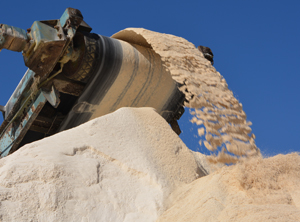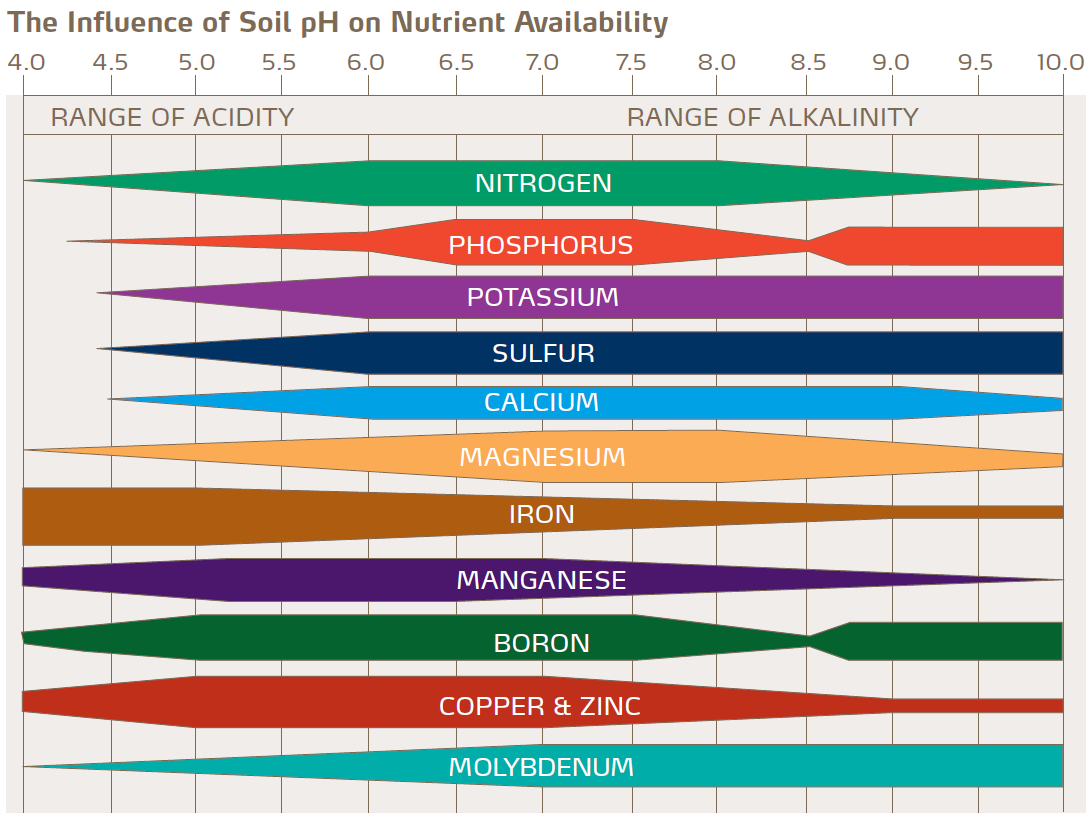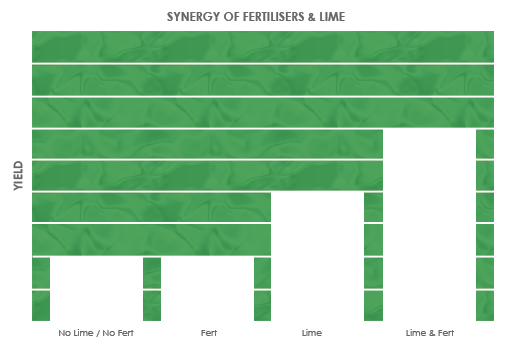
Ag Lime contains Calcium & Magnesium which is essential in agriculture.
From the beginning of time, Adam was told to dress and to keep the land. Meaning that Adam had the important job of supplying what was needed in order to build up the soil.
As a rule, land left to itself does not get better, instead it deteriorates. While this may happen slowly, it does happen. Our jobs, are therefore, to keep our crops flourishing by providing exactly what it needs…
Unfortunately, there has been some confusion on what our crops really need to produce high-yielding, quality crops.
The fertilizer industry has pushed their product so hard that many people think this is all you need to place into your soil.
On another side, some people believe that liming your soil is only needed so that you can reach the right pH soil level and then you’re done… Again this is incomplete information.
Our goal here, is to fully walk through a better understanding of what you really need to grow high-yielding crops that are full of nutrients!
Agricultural Lime & What It’s Normally Used For
Liming the soil in Belize and anywhere else is very important. Knowing that Belize’s economy relies heavily on agriculture, it becomes essential to sustain production year after year.
Overall, farmers who are still in the dark about the true benefits of liming, mainly use Ag Lime for pH management… Especially farmers in Southern Belize where the pH level can be as low as 4.5.
Some General Advantages From Liming Acid Soils Are…
- Lowers toxic levels of Aluminum, Manganese, and Iron.
- Increases some microbial activity-decomposition.
- Overcomes the potential for calcium or magnesium deficiencies.
- Increases symbiotic nitrogen fixation in legumes.
- Increases availability of phosphorus and molybdenum.
- Enhances the effectiveness of herbicides.
And as you can see in the chart below, having the most optimal pH range is important in nutrient availability…

The advantages above are good enough reasons to consider liming your crops, however, it gets even better! Keep reading…
Here’s something to also consider about White Lime, this is not an overnight solution… Liming your soil is a long term process that guarantees long term results. Whereas, other products may give you some results overnight, there’s no guarantee as to what kind of shape your soil be in next year.
Our customers in Southern Belize especially, have seen gradual improvements in their pH level every year and have achieved higher crop yields and healthier looking crops… With that said, how often you should lime your soils will vary depending on:
- Soil texture
- Nitrogen fertilization rates.
- Calcium and magnesium crop removal.
- Amount of lime applied.
- And soil pH range desired.
For now, let’s move onto why agricultural lime is no longer just thought of as a pH management tool.
Calcium & Magnesium for High-Yielding & Healthier Crops
There are four main elements when it comes to controlling your soil’s pH: Calcium, Magnesium, Potash, and Sodium.
Magnesium alone is a powerful base that can raise the pH up to 1.67 times as high as Calcium. However, while a soil high in Magnesium can test above a 6.5 pH, it wouldn’t be effective for the growth of alfalfa or the growth of legume bacteria, and most of all it wouldn’t create the environment necessary for the decay of organic crop residues into humus. Therefore, it’s important to test your soil so that you have the right amount of elements for optimal growth, instead of going by pH alone.
It’s crucial to manage the four elements (Calcium, Magnesium, Potash, and Sodium) that create your soil’s pH than to be concerned with Nitrogen, Potassium, and Phosphorus… WHY?…
- Help Decay the Soil: Having full levels of Calcium and a reasonable amount of Magnesium help with the conversion and availability of mineral elements through the system of decay in the soil.
- Help Release Mineral Elements Into the Soil: A balanced equilibrium of Calcium and Magnesium creates a soil environment for bacteria and fungus to properly decay organic material into CO2, carbonic acid and a host of many weak and mild organic acids, all of which are necessary to convert and release mineral elements in the soil system.
- Maintain Much Needed Bacteria: An imbalanced equilibrium of Calcium and Magnesium causes organic material to decay into alcohol, which kills the much needed bacteria; and into formaldehyde, a preservative of cell tissue. (A quick test for this issue can be seen when previous year’s stalks are plowed back up just as shiny and fresh as they were when turned down.)
- Fully Make Use of Fertilizers: When an imbalance occurs, larger and increasing amounts of nitrogen and fertilizer minerals will be required to maintain normal crop yields. This is because the soil will not be able to release the minerals or other soil essentials for optimum growth.
- Maintain a Healthy Amount of Humus: By not having enough Calcium and applying more nitrogen you’ll consume larger amounts of calcium as well as “burn-up” crop residues and humus. You can normally get increased yields for a few years from a stored up wealth of humus, but eventually you will have account for this withdrawal.
- Be Able to Grow Your Crops! Finally, without an active organic matter system produced with the help of Calcium and Magnesium, the soil cannot grow any crop at all; no matter how much nitrogen, potassium, and phosphorus you add.
Yes, fertilizers are still needed and recommended, however, research in agriculture is showing the importance of Calcium and Magnesium… Which have not been recognized very much before… If anything, they have been considered of second importance compared to commercial fertilizers.
Yet, research is showing that for soil and plants, Calcium & Magnesium are of primary importance both quantitatively and also for their bio-chemical significance.
In fact, there probably wouldn’t be a green plant if it wasn’t for Magnesium because it controls the development and bio-chemistry of the chlorophyll molecule. As a result, there wouldn’t be no photosynthesis, which means no food for other forms of life…
Just check out the table below to see the importance of white lime and fertilizers in crop yield…

Research is showing that fertilizing your soil is not enough. For best crop yield, you need both White Lime and Fertilisers.
It’s been estimated that both Calcium & Magnesium are so vital to a plant growth that you need to have 1,000 to 36,000 pounds of the so called exchange calcium and 200 to 3,000 pounds of the exchange magnesium per acre to produce a healthy and high yielding crop!
By taking an active role in managing your Calcium & Magnesium levels, you will be creating more active and healthy soils for your crops and at the same time diminish or even eliminate several problems that normally occur when growing crops…. Some of these benefits and affects are:
- More efficient photosynthesis.
- Maximum use of heat-degree days, a natural time clock of the life systems of plants.
- Creates and maintains the root and stem capacities for optimum use of sunlight energy and thermal efficiency by the leaves of the plant. As a result, plants are able to use water, CO2, nitrogen, and mineral nutrients with greater efficiency.
- By having a normal and healthy plant, it will be able to maintain an adequate hormone and enzyme system in order to resist insect and diseases.
- A balanced soil equilibrium will regulate and mange the quality and availability of all mineral elements needed by growing plants.
- Too much minerals during the early growth stages of plants can often plug up the vessels of the stem, which normally leads to early death.
- Too much Magnesium as well as Nitrogen in the soil prevents a crop from growing dry and nutritionally ripe, which is the goal of every farmer.
- Carbon dioxide availability is more vital for high-yield potentials than nitrogen or any other mineral element. The CO2 found in the atmosphere could sustain life for about 30 days, the plant depends on the soil decay system to replenish its supply. Without the beneficial effects of Calcium in the soil system and its effect on soil structure and tilth, the processes becomes inefficient.
- Clay soils high in Magnesium and low in Calcium cement together tightly, are subject to compaction and clodding, crust over easily and prevent the insoak of water and the recovery of capillary water during the dry periods of the season.
- Soils in such poor tilth and structure increase the effects of the many weather hazards that annually impair normal plant growth.
Thus, by managing the Calcium and Magnesium equilibrium, we would have crops that flourish beyond what we would expect!
How to Get the Most From Your Farming…
According to the Belize Citrus Growers Association, the optimum soil pH for citrus tree growth and development is 6.0 (slightly acid). In areas such as those in the Stann Creek, Toledo Districts, and other areas in Southern Belize; many years of heavy rainfall, fertilizer application and farming has caused the pH to fall. pHs of 4.0 or even lower are not uncommon on soils in the Stann Creek District that have not had lime applied for many years.
As a result of this low pH, citrus growers and other farmers in general are losing money from fertilizer not being used to it’s full potential, lower quality product, and lower yields…
If you’re planning on continuing to farm every year on the same land, you NEED a long range program where Calcium and Magnesium come first through liming of your soil…
This does not mean that we forget about Nitrogen, Phosphorus, Potassium, and Sulfur. These primary elements always come first where needed for growing the immediate crop. However, to have optimal efficiency of overall nutrient uptake, Calcium & Magnesium has to be in the soil in sufficient amounts.
How much Calcium & Magnesium you have in your soil is normally determined through soil testing because Calcium Deficiency is rarely visible in the field. Some side effects can occur however. For example, high soil acidity will usually limit growth first. Additionally, a high soil acidity causes manganese, aluminum, and iron toxicity.
Calcium is so crucial that it’s recommended to have 60 to 70% Calcium around the plant root hairs. If there is not enough Calcium, you will need more Potassium, Phosphorous, and Nitrogen around the root hairs to get the same amount of that nutrient into the plant. Every other nutrient has to ride over the back of Calcium to get into the plant!
Additionally, without adequate amounts of Magnesium, photosynthesis slows down… Resulting in your plant having less energy to sustain itself…
Below is just an example of the amounts of Calcium & Magnesium you need for optimal corp yield…
| Crop | Yield Level | Calcium | Magnesium |
| Corn | 84 bags/acre | 42 lbs | 44 lbs |
| Oranges | 600 boxes/acre | 80 lbs | 38 lbs |
| Bananas | 607 cartons/acre | 10 Kg | 8 Kg |
| Oranges | 540 cwt/acre | 80 lbs | 22 lbs |
| Rice | 7,000 lbs/acre | 20 lbs | 14 lbs |
Our Customers recognize the need for our white lime (agricultural lime) to balance the Calcium and Magnesium in their soil. For example, our South Belize Customers have been in business with us for several years because every year they see improvement in their soil’s pH (which is normally around 4.5 before hiring us) and see visible improvements in the health of their crops and plants.
As Manager of Limbe, I find it very important to know all I can about growing the best crops possible so that I can better help you to make the right decisions for optimal yield. With one simple call, I can recommend the best soil treatment for your crops and plants. Simply contact me below:
~ Milton P. Dueck, Manager of Limbe
Route 35 West
Spanish Lookout; Belize
670-5604
Learn more about the importance of white lime from agriculture expert, Neal Kinsey. He’s studied nutrient deficient soils in the United States, Belize, and several other places around the world.. Find out what he has to say about Belize’s agriculture below…
Side Notes on Calcium and Magnesium…
Calcium Defined…
- a silver white bivalent metallic element of the alkaline earth group occurring only in combination
- chemical symbol Ca
- a plant nutrient that should occupy between 60 and 70% of the positions on the soil colloid in terms of the exchange capacity
- at the proper saturation, improves soil texture, makes phosphorus and micro-nutrients more available, and improves the environment for microorganisms
- helps plants form better root systems, stems and leaves for efficient use of sunlight energy, water carbon dioxide, nitrogen and mineral nutrients
- most important fertilizer element
- essential for building normal bones and teeth, important in blood coagulation, and lactation; enables heart, nerves and muscles to function; regulates permeability of tissue cells
How does Calcium serve in the growth of plants?
- It creates better feed for young animals.
- It creates better feeds for growth and reproduction.
- It’s involved in the soil’s microbial process that build up soil nitrogen.
- It’s effective in making green manure and other organic matter decay more rapidly and release their fertility for crop production.
- Puts the starch into the leaf.
- Activates several enzyme activities.
- Increases yield by reducing soil acidity.
- Calcium improves microbial activity.
- By having more Calcium than Magnesium, you avoid the plant poisoning effects of magnesium.
- Helps in the uptake of every other fertilizer nutrient.
[huge_it_gallery id=”2″]
Magnesium defined…
- a silver-white light malleable ductile metallic element
- chemical symbol: Mg
- occurs abundantly in nature as an alkaline earth
- used in many industrial processes, including photography, pyrotechnics
- MgO used in fertilizers, cement, insulation
- in medicine, the magnesia is an antacid and mild laxative
- in soils, magnesium has 1.67 times as much exchange capacity as an equal amount of calcium
- high magnesium and low calcium permits organic residue to decay into alcohol, a sterilant to bacteria
- it should occupy between 10 and 20% of the soil’s exchange capacity
- in the human body, it is essential for nerve and muscle activity and in bone structure, aids in growth promotion
How does Magnesium serve in the growth of plants?
- A mineral constituent of chlorophyll.
- Actively involved in photosynthesis.
- Aids in phosphate metabolism.
- Activates several enzyme systems.
[huge_it_gallery id=”3″]
References:
- Hands On Agronomy: Understanding Soil Fertility & Fertilizer Use. By: Neal Kinsey & Charles Walters. 3rd Edition. 2013.
- Lecture: The Albrecht/Kinsey System of Soil Fertility. Course Instructor: Neal Kinsey. May, 2015.
- Secondary Nutrients. Crop Nutrition.
- Fertilizer & Liming. Belize Citrus Growers Association.
- Synergy of Fertilisers & Lime Table. Generoit.com
